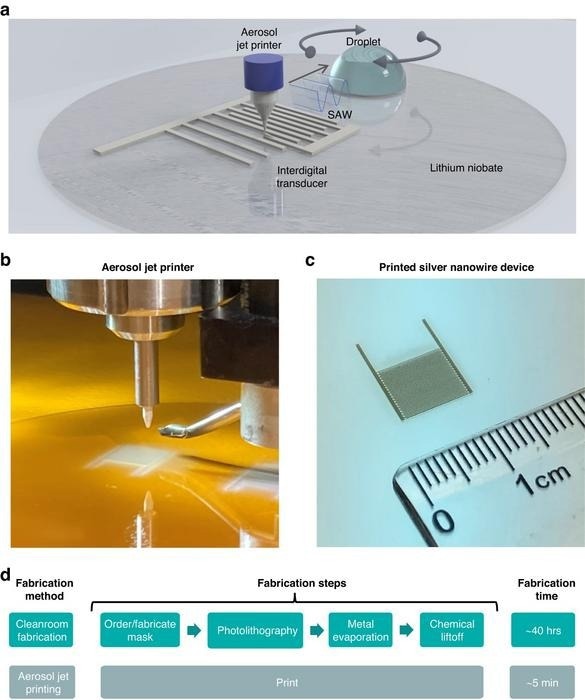SAW technologies have a wide range of applications in research and are crucial to microfluidics because of their high accuracy and quick actuation. However, conventional fabrication techniques are labor-intensive, and complex, and need expensive cleanroom facilities. By using aerosol jet printing to make bespoke devices using different materials, such as graphene and silver nanowires, one innovative technique gets around these limitations and drastically shortens the development time.
 Aerosol jet printing process for surface acoustic wave (SAW) microfluidic devices. a Schematic of the fabrication process and mechanism of the aerosol jet-printed SAW microfluidic devices. Interdigital transducers are fabricated via aerosol jet printing and actuated to create SAW that propagates into the droplet to allow for acoustic forces, including acoustic radiation and acoustic streaming, to act on the droplet and the particles inside the droplet. b Image of an aerosol jet printer with a printed PEDOT:PSS SAW microfluidic device. c Image of a silver nanowire-based interdigital transducer on a lithium niobate substrate. d Timeline and number of fabrication steps comparison between the cleanroom and aerosol jet printing fabrication methods for SAW microfluidic devices. Image Credit: Microsystems & Nanoengineering
Aerosol jet printing process for surface acoustic wave (SAW) microfluidic devices. a Schematic of the fabrication process and mechanism of the aerosol jet-printed SAW microfluidic devices. Interdigital transducers are fabricated via aerosol jet printing and actuated to create SAW that propagates into the droplet to allow for acoustic forces, including acoustic radiation and acoustic streaming, to act on the droplet and the particles inside the droplet. b Image of an aerosol jet printer with a printed PEDOT:PSS SAW microfluidic device. c Image of a silver nanowire-based interdigital transducer on a lithium niobate substrate. d Timeline and number of fabrication steps comparison between the cleanroom and aerosol jet printing fabrication methods for SAW microfluidic devices. Image Credit: Microsystems & Nanoengineering
Researchers from Virginia Tech and Duke University have pioneered integrating aerosol jet printing technology into the production of Surface Acoustic Wave (SAW) microfluidic devices. The study was published on January 1, 2024, in the journal Microsystems & Nanoengineering. Lab-on-a-chip applications can now be developed more quickly, more versatilely, and without the need for a cleanroom, changing a variety of sectors including biology and medicine.
In this innovative study, the group created Surface Acoustic Wave (SAW) microfluidic devices using aerosol jet printing. This approach stands in sharp contrast to traditional, laborious cleanroom procedures.
It entails depositing several conductive materials onto surfaces to generate interdigital transducers, essential for creating SAWs to manipulate fluids and particles at the microscale. These materials include graphene, poly (3,4-ethylenedioxythiophene) polystyrene sulfonate (PEDOT:PSS), and silver nanowires.
Surprisingly, this approach cuts manufacturing time from over 40 hours to about five minutes per device. Using a laser Doppler vibrometer, the researchers extensively examined the acoustic performance of these printed devices and compared it to cleanroom-fabricated devices.
The results indicated promising potential, with printed devices exhibiting comparable or acceptable performance levels in terms of resonant frequencies and displacement fields. This study marks a substantial leap in microfluidic device production, providing a speedier, more versatile, and more efficient alternative to existing app"roaches.
This isn’t just a step forward; it's a leap into the future of microfluidic device fabrication. Our method not only simplifies the process but opens up new possibilities for device customization and rapid prototyping.
Dr. Zhenhua Tian, Study Co-Author and Assistant Professor, Department of Mechanical Engineering, Virginia Tech
The novel technology has far-reaching consequences, making microfluidic device production more accessible, quicker, and cost-effective. It has the potential to speed up research and development in a variety of sectors, resulting in faster diagnostics, better medication delivery systems, and more accurate biochemical tests. Furthermore, the technology’s flexibility indicates its applicability to a wide range of materials and substrates, implying broad applications across several disciplines.
Journal Reference:
Rich, J., et. al. (2024) Aerosol jet printing of surface acoustic wave microfluidic devices. Microsystems & Nanoengineering. doi:10.1038/s41378-023-00606-z.